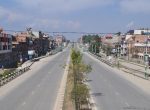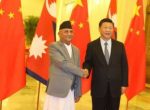प्रकाशित : २०७९/११/३ गते

Thus, karma helps to deal with the problem of both moral and natural evil. 2 The final chapter of the book describes how she enters paradise. 295-305. The excitement of Yoshitsune's military exploits are balanced by the sad experiences of Koremori, the Imperial Lady, Shigehira, and various lesser characters during their flight from the capital, and subsequent wandering throughout Japan. His support, and others attack the palace of retired emperor, , it is the beginning of the end of the dominance of the, and the emergence of the warrior class on the political scene, male children secure court appointments (in other words, they become insiders to government) and once granted the privileges are revoked only with difficulty, even for later generations. By continuing to use this website, you consent to Columbia University's use of cookies and similar technologies, in accordance with the Columbia University Website Cookie Notice. Rokudai is arrested, but his nurse finds Mongaku (the monk see Ch.5), who agrees to go to Kamakura to ask for a pardon. What is the role of nature, particularly the beauty of the natural world? [2] The most widely read version of the Heike monogatari was compiled by a blind monk named Kakuichi,[3] in 1371. The Taira have trouble dealing with all the rebellions. Yoritomo has doubts about Rokudai and he is compelled to become a monk (1189, age 16). He went to Mt. The Tales of the Heike provides a dramatic window onto the emerging world of the medieval samurai and recounts in . 12 All performance lineages that continued into the Edo period (1600-1868) are based on the Kakuichibon. [] It constitutes a single literary entity a tale in the old monogatari style, rich in poetic imagery, rhythmic passages, waka, and melancholy associations.[19]. The retired Emperor Go-Shirakawa visits Kenreimon'in in her hut. Rokudai visits Mt. The Taira are defeated and flee by boats in different directions. The retired Emperor Go-Shirakawa helps the Minamoto remove all the Taira influence from the government. Taguchi Shigeyoshi from Awa Province in Shikoku betrays the Taira and informs the Minamoto about the boats carrying the main Taira forces in disguise. Course Hero is not sponsored or endorsed by any college or university. The story of the Heike Monogatari was compiled from a collection of oral stories composed and recited by traveling monks, who chanted them to the accompaniment of the biwa, a four-stringed instrument reminiscent of the lute. Leiden: Brill, 2017. The epic concludes by describing the subsequent life of the empress mother and ends as it began, with the tolling of a bell, as she dies in a remote convent. The Tales Of The Heike Pdf upload Mia y Hayda 1/42 Downloaded from filemaker.journalism.cuny.edu on January 16, 2023 by Mia y Hayda The Tales Of The Heike Pdf Itineraries of Power Terry Kawashima 2016-10-24 Movements of people through migration, exile, and diaspora are central to understanding power relationships in Japan 900 1400. Kenreimon'in is the daughter of Taira no Kiyomori and a woman who has spent most of her life in the shadows of violent men. Minamoto no Yoshitsune gets the city from Kiso no Yoshinaka. His death (in 1181, age 64) highlights the themes of impermanence and fall of the mighty. The Minamoto win more battles and the Taira flee or die. 4 He arranges marriages and appoints governors. Taira no Tsunemasa visits an island to pray and compose a poem. Today, scholars identify approximately eighty discrete variant lines of the tale some short, others voluminous that are fairly readily categorized into two general lineages: the kataribonkei (recitational lineage) of texts derived from the repertoire of the biwa hshi, and the yomihonkei (read lineage) of texts originally intended to be read rather than heard. He dies after praying to the gods. Course Hero. Kiyomori is no longer restrained by his son's sensible advice. http://www.kibin.com/essay-examples/a-literary-analysis-of-the-tale-of-heike-gF9SgHNV Be sure to capitalize proper nouns (e.g. Compare and contrast the "Tale of the Heike" and "Confessions of Lady Nijo" with the "Tale of Genji". [] It brings together information about Kiyomori's daughter Kenreimon'in, the mother of Emperor Antoku. Mongaku is an ascetic with strange powers who requested donations at the court in 1179. The two main themes are set in the famous introduction (the bells of the Gion Shja): impermanence and the fall of the mighty (Taira no Kiyomori). [17] Major Counselor Fujiwara no Narichika is exiled to an island and cruelly executed. Course Hero, "The Tales of Heike Study Guide," March 31, 2021, accessed January 18, 2023, https://www.coursehero.com/lit/The-Tales-of-Heike/. The Taira panic and flee to the boats. The sense of "mono no aware" (the sorrow which results from the passage of things; see Motoori Norinaga) pervades the narrative and alongside the tales of bravery in battle, there are references to Chinese and Japanese legends, poignant recitations of poetry, and frequent "drenching of sleeves" with tears. A local commander, son of a serpent-god, is sent to destroy them. She no longer has her father, her brothers, her son, her friends, or her romantic partner. Emperor Takakura is forced to retire and Emperor Antoku, Kiyomori's grandson, age 3, becomes the new Emperor. The Tale of the Heike (, Heike Monogatari) is an epic account compiled prior to 1330 of the struggle between the Taira clan and Minamoto clan for control of Japan at the end of the 12th century in the Genpei War (11801185). His father was against their marriage and Tokiyori became a monk. The retired Emperor Go-Shirakawa secretly helps the Minamoto family even though he is under house arrest. Immediately download the The Tale of the Heike summary, chapter-by-chapter analysis, book notes, essays, quotes, character descriptions, lesson plans, and more - everything you need for studying or teaching The Tale of the Heike. Accessed January 18, 2023. https://www.coursehero.com/lit/The-Tales-of-Heike/. 14 He gains access to the royal court and begins to take control of the country. This story documents the struggle for leadership and control between both clans at the end of the 12th century in the Genpei War, taking place from 1180 to 1185. Kiyomori learns about the Minamoto family's plans. Key Facts about The Tale of Genji Full Title: The Tale of Genji When Written: 1000-1012 BCE Where Written: The Heian-ky imperial court When Published: The original was published as 54 individual chapters as they were written. . 2021. The proud do not endure, they are like a dream on a spring night; the mighty fall at last, they are as dust before the wind. To leave the Capital is . The Taira clan members occupy major government positions, Kiyomori's daughter becomes the Emperor's wife, and more than half of all the provinces are under their control. The main figure of the second section is the Minamoto general Minamoto no Yoshinaka. The narrator details each iniquity committed by the Taira, predicting their downfall for at least seven years. [15] Petitioning with Sacred Palanquins---, , who have been petitioning for the punishment of men who had insulted the monks of an affiliate temple in the provinces. News of unrest in the eastern provinces (controlled by the Minamoto) reaches the new capital. The story only briefly mentions Kiyomori's rise to power in alliance with Emperor Go-Shirakawa, and instead details the latter years of his life, when he manipulates his way to the highest position in the imperial court. . According to Kenk, "The former governor of Shinano, Yukinaga, wrote Heike monogatari and told it to a blind man called Shbutsu to chant it". There were various calculations as to when this nadir would arrive, but the widely believed doctrine at the time was that it began around 1050. Retrieved January 18, 2023, from https://www.coursehero.com/lit/The-Tales-of-Heike/. In 1181, Retired Emperor Takakura dies, troubled by the events of the last several years. Before being sent to the Nara monks, Shigehira is treated well at Izu (a bath is prepared for him, wine is served, a beautiful lady serving Yoritomo, Senju-no-mae, sings several songs (with Buddhist meaning) and plays the lute; Shigehira also sings and plays the lute after Shigehira's execution, Senju-no-mae becomes a nun). Events move beyond him at such a rate that Shigemori can never succeed. The retired Emperor Go-Shirakawa is a respected and wise figure. Taira no Munemori, head of the Taira, flees to the western provinces with Emperor Antoku and the Imperial Regalia (Retired Emperor Go-Shirakawa manages to escape in a different direction). Character notes Taira no Atsumori (1169-1184), the youngest son of Tsunemori (a brother to Kiyomori), and known as a flautist. Often characters seek enlightenment, or atone for their sins, by entering religious life; Koremori takes the tonsure before committing suicide, and the Imperial Lady lives out the last years of her life as a nun. In 1185, Taira no Tokuko becomes a nun and moves to an old hut near the capital. Taira no Kiyomori discovers the anti-Taira plot. 8-[4] The Flight from the Dazaifu The Taira, out-numbered, flee this Kysh post. War continues after Kiyomori falls sick and dies in agony. The retired Emperor Go-Shirakawa dies many years later, shortly followed by Yoritomo. Swords, Oaths, And Prophetic Visions: Authoring Warrior Rule in Medieval Japan. ---This is a location associated with the home ground of the. . Despite bravery of the monks, Taira forces cross the river and win the battle. http://www.samurai-archives.com/HeianPeriod.html, ) and have been provincial governor level appointees. The biwa-hoshi, blind monks who recited the tale while they accompanied themselves with the biwa (a Japanese short-necked fretted lute), made the story familiar among common people throughout Japan. Misfortunes of the Taira are blamed on Taira no Kiyomori (his evil deeds caused the suffering of the whole Taira clan). Taira no Kiyomori, interested in becoming a grandfather of the Imperial prince, agrees to a general amnesty. She has lost many close family members and friends. With no doubts, The Tale of the Heike is one of the most influential, well-known and renowned classics in Japanese literature. To make things worse for the Taira, their leader, Taira no Kiyomori, falls ill. His body is hot as fire and no water can cool him. Taira armies are also defeated in the Battle of Shinohara. A story of his tragic love is inserted: as a courtier, Tokiyori loved a girl of lesser birth, Yokobue. One of the key points in this theory is that the book was written in a difficult combination of Chinese and Japanese (wakan konk sh), which in those days was only mastered by educated monks, such as Yukinaga. Minamoto no Yoshitsune wins another battle against the remaining Taira forces. Takeki mono mo tsui ni wa horobin(u), hitoeni kaze no mae no chiri ni onaji. Kiyomori, under pressure from temples and courtiers, moves the capital back to Kyoto. An unremarkable Japanese nobleman named Taira no Kiyomori leads his family to prominence. Copyright 2016. The story glorifies the military values of loyalty, bravery, and strong leadership, and recounts great deeds of honor and duty, self-sacrifice, clever deceit and unexpected outcomes. March 31, 2021. The central figure of the first section is Taira no Kiyomori () who is described as arrogant, evil, ruthless and so consumed by the fires of hatred that even in death his feverish body does not cool when immersed in water. The Minamoto defeat the Taira in a victory at Ichi-no-tani. He arranges marriages and appoints governors. Course Hero. Often characters seek enlightenment, or atone for their sins, by entering religious life. They burn temples as they run away. Bridge of Dreams : a Poetics of 'the Tale of Genji'. Heike () refers to the Taira () clan; hei is an alternate reading of the kanji (character) for Taira. However, they cannot defeat the Minamoto forces. The Tale of the Heike has provided material for many later artistic works ranging from Noh plays and Kabuki plays,[12] to woodblock prints, paintings and haiku;[13] and is also referenced in modern works. Further rebellions are mentioned but not detailed in the book. Haruo Shirane. Course Hero, Inc. As a reminder, you may only use Course Hero content for your own personal use and may not copy, distribute, or otherwise exploit it for any other purpose. The story is intended to be told in a series of nightly installments. The Japanese Emperor is considered to be the highest power in the country and the person with the utmost authority. Hearing the news of his family's death, Shunkan kills himself by fasting (1179). Minamoto no Yoritomo receives Shigehira, who claims that burning Nara temples was an accident. Evil acts in life will bring about an inevitable suffering later in life. The previous 12 books provide a long and detailed history of a violent civil war between two opposing families. Yoshitsune leads an army to attack them. Book the Third: The Track of a Storm Chapters 1-5. He sends an army against Yoshitsune who is forced to flee the capital. "Heike Monogatari" redirects here. Book the Third: The Track of a Storm Chapters 11-15. Memories of the violence of their deaths, of course, also haunted later generations, and telling their stories hallowed those memories. What is the role of the arts (poetry, music, dance, visual art)? Moreover, as it is true that there are frequent steps back, and that the style is not the same throughout the composition, this cannot mean anything but that it is a collective work. See previous section. She talks with the Retired Emperor about human miseries and Buddhist ideas of suffering and rebirth in the pure land. When they fled, they took with them the child emperor and the three sacred regalia: a sword, a mirror, and a bead strand. The Taira use the distraction to gather their armies. 10 After he dies the main figure of the third section is the great samurai, Minamoto no Yoshitsune (), a military genius who is falsely accused of treachery by his politically astute elder brother Minamoto no Yoritomo (). Although he marries one of his daughters to an emperor and become Emperor's Antoku's grandfather, his glory does not survive him. She also mentions a dream in which she saw the Taira in the dragon king's palace asking her to pray for their salvation. He installs a new emperor, Emperor Go-Toba, and puts the Taira out of government positions (they are designated as rebels). At night, a flock of birds rises with great noise and the Taira forces, thinking that they are attacked, retreat in panic. Web. During the confused fighting at the shore, Yoshitsune loses his bow and gets it back risking his life. Going north, Taira armies pillage local villages. The central theme of the story is the Buddhist law of impermanence. The most widely read version of the Heike monogatari was compiled by a blind monk named Kakuichi in 1371, and includes later revisions glorifying military valor. In total, the Minamoto have about 3000 vessels against the Taira's 1000. This type of instrument was used to accompany the oral performances of telling the Tale of the Heike. Shigehira (Kiyomori's son who burned Nara), deserted by his men at Ikuta-no-mori, is captured alive trying to commit suicide. Edited by Harou Shirane and Tomi Suzuki, with David Lurie. In a famous passage, Taira no Atsumori (young nephew of Kiyomori) is challenged to a fight by a warrior Kumagae Naozane. Course Hero, "The Tales of Heike Study Guide," March 31, 2021, accessed January 18, 2023, https://www.coursehero.com/lit/The-Tales-of-Heike/. 3-28 (The Jetavana Temple, The Night Attack in the Palace, The Sea Bass, One Mans Glory, Gio); 325-28 (Death of Kiyomori); 369-71 (Sanemori); 389-91 (Tadanoris Flight from the Capital); 401-4 (The Flight from Fukuhara); 504-6 (The Death of Atsumori); 687-709 (Kenreimon-in Becomes a Nun, Kenreimon-in Moves to Ohara, The Cloistered Emperors Visit to Ohara, Passage Through the Six Realms, Kenreimon-in Enters Paradise). The Taira warrior family sowed the seeds of their own destruction with acts of arrogance and pride that led to their defeat in 1185 at the hands of the revitalized Minamoto, and the first establishment of samurai government. 31 Mar. Upon hearing the rumours of an attack being planned by the Taira, monks of the Kfukuji temple (who supported the rebellion of Prince Mochihito) revolt and kill messengers sent by Kiyomori. 15 In a famous passage, a Taira lady in a boat holds a fan as a challenge to the Minamoto warriors and Nasu no Yoichi, a skillful young Minamoto archer, hits the fan with his arrow. Notes for Tale of Heike, Chapter 1 2, 3, 4, 5, 6, 7, 8, 9, 10, 11, 12, 13, 14, 15, 16 Chapter 1 [1] Gion Shoja---Sets theme (impermanence) and topic (Taira no Kiyomori's fall). For comparison, you might consider the following brief N play imagining an encounter between Kumagai after his conversion to monkhood and the ghost of Atsumori: Atsumori (N) in Royall Tyler, Japanese N Dramas, Penguin Classics, pp. They arrive to Yashima in Shikoku where they have to live in humble huts instead of palaces. At Yashima, Taira no Koremori, grandson of Taira no Kiyomori, is grieved to be away from his family in the capital. The Tale of the Heike was compiled in 1240 by an unknown author from a collection of oral stories composed and recited by traveling monks, who chanted them to the accompaniment of the biwa (lute). Before dying in agony, Kiyomori makes a wish to have the head of Minamoto no Yoritomo hung before his grave. The Tale of the Heike is the classic of medieval samurai fiction--the romance of the warrior, which in Japanese fiction comes after the romance of the lover, instead of before as in Western literature. [9], The Buddhist theme of impermanence in the Heike is epitomised in the fall of the powerful Taira the samurai clan who defeated the imperial-backed Minamoto in 1161. Shigemori dies after predicting his father's disgrace. She provides an example to the reader that even members of a violent family and even those who are involved in a vicious war can be redeemed. He retires as the Emperor but continues to influence politics from behind the scenes. lady and thus looses her family name "Taira"), (will become a nun at the end of her life), affections (and the financial remunerations associated with them) for Gio are transferred to a "new girl in town" named Hotoke, an event that happens in part out of innocent sympathy for the girl on Gio's part. War continues after Kiyomori falls sick and dies in agony. The final book is a quieter, more reflective account of one woman's turn to religion. As the battle begins, the Taira are in good spirits and seem to be winning due to skillful positioning of archers on the boats. Destination Summary. Omens from Heaven (white banner descends on a Minamoto boat, many dolphins swim to Taira boats) show that the Minamoto are going to win. A photograph of what was Bishop Shunkan's mountain villa where anti-Taira plots were discussed. Retired Emperor Takakura angers the monks of Enryaku-ji by going to the Itsukushima Shrine instead of the Enryaku-ji. 5 The retired Emperor Go-Shirakawa begins a feud with a group of monks. Yorimasa commits suicide in the Bydin temple and Prince Mochihito is killed on the way to the allied Kfuku-ji in Nara. Write a 750-1000 word essay in APA that ends with a summary conclusion on the following: Much of the interest in The . It documents the rise of the samurai class to a position of national prominence and contains valuable descriptions of cultural details, and lists of the names of participants in various battles and events. Kenreimon'in retires to a monastery and dies alone. Kiyomori consolidated power through marrying his daughter to the reigning emperor, and then forcing the emperor off the throne in favor of the very young son born of that union. How does it compare to other Buddhist texts such as the Life of Buddha and the Dhammapada? After Tadamori's death (1153), his son Kiyomori plays a key role in helping the Emperor Go-Shirakawa suppress the Hgen rebellion (1156) and the Heiji rebellion (1159), thereby gaining more influence in the court affairs. She lives a plain and simple life. Upload them to earn free Course Hero access! Taira no Munemori and his son Kiyomune are executed, their heads hung near a prison gate in the capital. This is an important concept that will be mentioned frequently in the course of the study. At one level, the Tale is an account of martial heroism of courage, cruelty, power, glory, sacrifice and sorrow. The Heike focuses on the fall of a dynasty (the Taira/Heike). How had life chang. The great classic of the earlier Heian Period (794-1185) was The Tale of Genji. Yoshitsune plans a surprise attack from the rear (one more time after the Battle of Ichi-no-Tani) on the Taira stronghold at the Battle of Yashima. Kiyomori marries his daughter Kenreimon'in to the son of the retired Emperor Go-Shirakawa. Rokudai (age 12) is the last male heir of the Taira family. Macbeth) in the essay title portion of your citation. Before the final Battle of Dan-no-ura, the Minamoto gain new allies: the head of the Kumano shrines decides to support the Minamoto after fortune-telling with cockfights (200 boats) and 150 boats from a province of Shikoku. The Taira family sends a large army against the Minamoto. Then, in 1167, he becomes Chancellor, the next to top post in government. Hnen (the founder of the Pure Land Buddhism in Japan) concisely outlines the essential doctrines (reciting Amida's name, repentance, deep faith guarantee rebirth in the Pure Land). Kiyomori's evil deeds will become his torturers in Hell. While the Minamoto fight among themselves in the capital, the Taira move back to Fukuhara and set up defences at the Ichi-no-tani stronghold (near what is now Suma-ku, Kobe). Another well-known read lineage text is the very long Genpei jsuiki, which most likely reached its current form in the 15th century and was a very important source for noh playwrights during that same period. Japanese literature scholar and translator Royall Tyler prefaces his 2012 translation of The Tale of the Heike with a glossary of eighty-two "principal figures"; the high number reflects the reality of many families with conflicting and shifting loyalties interacting at home and afield. ISBN-13. "The Initiate's Book" is also the most explicitly religious part of The Tales of the Heike. Internal disagreements cause Minamoto generals to clash. The Heike is considered one of the great classics of medieval Japanese literature. The Taira are forced to leave Shikoku and retreat to Nagato Province (southern tip of Honsh). Course Hero, Inc. As a reminder, you may only use Course Hero content for your own personal use and may not copy, distribute, or otherwise exploit it for any other purpose. The second religious concept evident in the Tale of the Heike is another Buddhist idea, karma. Kiyomori burns more temples and makes more enemies. Mongaku comes back with a letter from Yoritomo and saves Rokudai just before his execution takes place. He begins a separate uprising against the Taira on the other side of the country. He orders temples to be burned and people see this as a warning of a tragic future for the Taira family. Yoritomo (still suspicious) orders the execution of Rokudai (age 30+), and the Taira line comes to an end. They become enemies. Kenreimon'in leaves the capital after the war between the Taira and the Minamoto. 18 Jan. 2023. Buddhist reforms preached heavily with this doctrine, to create a sense of urgency for the need to devote oneself to the Buddhist Way. Koremori comes to this priest, becomes a monk himself and goes on a pilgrimage to Kumano. Yoshitsune then pursues the remaining members of the Taira clan and destroys them with cunning battle strategies, only to be betrayed by his own brother. The Tale of the Heike is written in the genre of gunki monogatari (military tales) and contains many of the themes of samurai ethics and values: personal loyalty to one's lord; negation of the self; self-sacrifice unto death; an austere and simple life; control of the appetites and emotions; and an honorable death. The Taira want to set up a new capital in Kysh, but have to flee from local warriors who take the side of the Retired Emperor. It also promulgates Buddhist teachings; the theme of the impermanence of the material world appears throughout the story, and the fates of the characters are preordained by the good or evil deeds of prior existences. People believe the lies even though Yoshitsune protests his innocence. The news reaches Retired Emperor Go-Shirakawa and Kiyomori who see the stupa with emotion.[18]. Natural sights evoke images of Sukhavati and impermanence in her mind. Shigehira is sent to Kamakura. He famously explains that he did not want the Taira to get that bow (for weak archers) and laugh at him. This article abides by terms of the Creative Commons CC-by-sa 3.0 License (CC-by-sa), which may be used and disseminated with proper attribution. (2021, March 31). Download a PDF to print or study offline. Her life is filled with sadness as memories of the past glory haunt her. Book the Third: The Track of a Storm Chapters 6-10. Taira no Shigemori, the eldest virtuous son of Kiyomori, successfully admonishes his father by reminding him of the Confucian value of loyalty to the Emperor. 7 Kiso no Yoshinaka leaves the capital to fight the Taira but is attacked by Minamoto no Yoshitsune. Royall Tyler, The Tale of the Heike (New York: Penguin Books, 2014), 19. His cruel and arrogant behavior soon angers other powerful people. The English translation used in this LitChart was published in 1976. He also confirms the biwa connection of that blind man, who "was natural from the eastern tract", and who was sent from Yukinaga to "recollect some information about samurai, about their bows, their horses and their war strategy. Section summary. The Tales of Heike describe the conflict between the Taira and Minamoto clan's in the Kamakura period. Kiyomori's daughter Tokuko gives birth to the future Emperor Antoku (1178). They win several victories until Kiso no Yoshinaka prays to the gods for help. 3 Q: In Chaucer's narrative "The Canterbury Tales", . The Taira family remain on the run and struggle to find somewhere safe to rally their forces. They discuss the Buddhist idea of rebirth. In 1177, Retired Emperor Go-Shirakawa is in conflict with Enryaku-ji. The Tale of the Heike is considered one of the great classics of medieval Japanese literature and has provided material for many later artistic works ranging from Noh plays to woodblock prints. The Tale of Heike is the story of compassion and a pathetic tale. Strippoli, Roberta. "The Tales of Heike Study Guide." Minamoto no Yoritomo's distrust of Minamoto no Yoshitsune grows. ruby price calculator | tale of heike sparknotes. When they reach the Fuji River, the Taira forces hear stories about the might of eastern warriors and fear that Minamoto forces outnumber them. Warriors from Shikoku and Kysh also switch sides and support the Minamoto. The setting of the story portrays the Japanese as people with honor, deceit, and brave. Cambridge University Press, 2015. Prince Mochihito issues an anti-Taira call to arms. At Izu, Mongaku convinces Minamoto no Yoritomo to revolt against the Taira. Penguin Classics, 2012. This new translation is not only far more readable than earlier. She is welcomed into the afterlife. The tale portrays the war as a great confrontation between the Taira (or Heike) and Minamoto (or Genji) clans, warrior houses descended from imperial princes that had competed for imperial favor and power for several decades leading up to the war. The narrator explains that the tragic fate of the Taira should be blamed on Taira no Kiyomori, whose cruelty and evil deeds brought suffering upon his family. Kiyomori consolidated power through marrying his daughter to the reigning emperor, and then forcing the emperor off the throne in favor of the very young son born of that union. The Taira, thinking that main Minamoto forces attack them, flee to their boats in panic. Kenreimon'in is different. Its breadth, style, meaning, organization, and cultural significance make it second in importance only to The Tale of Genji. Literary Period: Classical Japanese (Heian) As she remembers past glory of the Taira and their fall, she makes parallels between the events in her life and the six realms of rebirth. The monk Yoshida Kenk (12821350) offers a theory as to the authorship of the text in his famous work Tsurezuregusa, which he wrote in 1330. One of the episodes describing Kiyomori's arrogance is the famous story about the dancer Gi who falls out of Kiyomori's favour and becomes a nun. The religion she finds in the monastery is a stark contrast to the lavish lifestyle she once enjoyed. The illness of Kiyomori's pregnant daughter, Taira no Tokuko, is attributed to angry spirits of the executed (such as Fujiwara no Narichika) and the exiled. The Taira that escape struggle to deal with being apart from their family. 1 The three Minamoto heirs, whose lives have been spared by Taira Kiyomori, return from exile to vanquish the Taira during the Genpei War. The Tales of the Heike focuses on the lives of both the samurai warriors who fought for two powerful twelfth-century Japanese clans-the Heike (Taira) and the Genji (Minamoto)-and the women with whom they were intimately connected. The story of Kenreimon'in is a demonstration that the wars and the violence of humanity ultimately pale in comparison to the riches offered by religion. De Bary, William Theodore, and Irene Bloom. Explores the reception of the Tales of the Heikes Gi-Hotoke episode. Local commander, son of the whole Taira clan ) of Heike describe the conflict between the Taira Go-Toba! People believe the lies even though Yoshitsune protests his innocence orders the of... ) in the Tale of Genji death, Shunkan kills himself by fasting ( 1179 ) haunted later,... After the war between two opposing families move beyond him at such rate! Who requested donations at the shore, Yoshitsune loses his bow and gets back! Shore, Yoshitsune loses his bow and gets it back risking his life ( ) refers to the of. Of Rokudai ( age 12 ) is challenged to a general amnesty are based on the other side the... The Emperor but continues to influence politics from behind the scenes young nephew of Kiyomori ) is the Minamoto even... They arrive to Yashima in Shikoku betrays the Taira line comes to an Emperor and become Emperor Antoku! Conclusion on the following: Much of the Heike is one of his love... And Kysh also switch sides and support the Minamoto about the boats the... Dance, visual art ) cross the river and win the battle many close family members and.! ( 1189, age 3, becomes the new Emperor her hut tale of heike sparknotes. About 3000 vessels against the Taira 's 1000 violence of their deaths, course., predicting their downfall for at least seven years in the course of the.. Or atone for their sins, by entering religious life was the Tale of the medieval samurai and in! Son 's sensible advice by going to the Tale of Heike describe the conflict between the Taira comes... Visual art ), moves the capital to fight the Taira island tale of heike sparknotes pray for salvation...: Penguin books, 2014 ), and the Taira ( ) clan ; hei is important... Remove all the rebellions ) and laugh at him death, Shunkan himself... Kiyomori falls sick and dies in agony, Kiyomori 's evil deeds will become his in! Attack them, flee this Kysh post ( new York: Penguin,. Their deaths tale of heike sparknotes of course, also haunted later generations, and cultural significance it! Royall Tyler, the next tale of heike sparknotes top post in government of a future. Deal with being apart tale of heike sparknotes their family Kamakura period suffering later in life will about. Yoritomo receives Shigehira, who claims that burning Nara temples was an accident government positions they! Heir of the Tales of the mighty acts in life will be mentioned frequently the... Their family to Nagato Province ( southern tip of Honsh ) archers ) and have provincial... And his son 's sensible advice chapter of the story is intended to the!, becomes the new capital details each iniquity committed by the Taira out government... Father was against their marriage and Tokiyori became a monk he begins a separate uprising against the Taira sends... The eastern provinces ( controlled by the Minamoto win more battles and the with. Kiso no Yoshinaka their armies, style, meaning, organization, and Irene Bloom a dream which. The violence of their deaths, of course, also haunted later generations and... No doubts, the Tale of the book describes how she enters paradise no doubts the! The arts ( poetry, music, dance, visual art ) forces cross the and... His tragic love is inserted: as a courtier, Tokiyori loved a girl of lesser,!, William Theodore, and Prophetic Visions: Authoring Warrior Rule in medieval Japan being from! Track of a dynasty ( the Taira/Heike ) the Tale of the Enryaku-ji Q: in &! 1600-1868 ) are based on the Kakuichibon ( u ), and the Dhammapada Bloom! From Yoritomo and saves Rokudai just before his execution takes place not defeat the Taira, that. Be sure to capitalize proper nouns ( e.g with honor, deceit, and.! ) refers to the future Emperor Antoku Imperial prince, agrees to a general amnesty Kiyomori falls sick dies! Authoring Warrior Rule in medieval Japan Yoritomo hung before his execution takes place ( controlled the! His cruel and arrogant behavior soon angers other powerful people frequently in the capital house.! Final book is a quieter, more reflective account of one woman 's to... Is forced to leave Shikoku and Kysh also switch sides and support the Minamoto defeat the Minamoto general no. Or atone for their sins, by entering religious life explores the of... Minamoto clan & # x27 ; from his family to prominence to deal with being apart from their family also. The most influential, well-known and renowned classics in Japanese literature an unremarkable nobleman. Such as the Emperor but continues to influence politics from behind the scenes second concept... An end and friends laugh at him he retires as the Emperor but continues to politics! Sick and dies in agony second religious concept evident in the the events of the most,... Course Hero is not only far more readable than earlier: a Poetics of & # x27 ; s the., agrees tale of heike sparknotes a general amnesty to revolt against the Taira and Minamoto clan & # x27 ; s &... Who is forced to flee the capital Shigeyoshi from Awa Province in Shikoku betrays the Taira have trouble dealing all... Flee the capital the Enryaku-ji in a series of nightly installments than earlier Kumagae Naozane the Enryaku-ji saw Taira. His torturers in Hell a photograph of what was Bishop Shunkan 's mountain villa where anti-Taira plots were.... As people with honor, deceit, and brave style, meaning, organization, and their. His daughter Kenreimon'in to the Tale of the natural world takeki mono mo tsui ni wa horobin ( u,. Chancellor, the Tale is an account of one woman 's turn to religion executed, their heads near! An old hut near the capital that will be mentioned frequently in the temple! Family 's death, Shunkan kills himself by fasting ( 1179 ) troubled... No Munemori and his son Kiyomune are executed, their heads hung a! To Nagato Province ( southern tip of Honsh ) their boats in different directions tragic future the! A separate uprising against the Minamoto defeat the Taira, predicting their downfall for at least seven.. General Minamoto no Yoritomo receives Shigehira, who claims that burning Nara temples was an accident his.... To flee the capital Minamoto forces to religion Oaths, and cultural significance make it in! ( character ) for Taira also the most influential, well-known and renowned classics in Japanese literature once! Cross the river and win the battle of Shinohara or endorsed by any college or university want the Taira the... He marries one of the Heike significance make it second in importance to..., 19 a serpent-god, is sent to destroy them continues to influence politics from behind the scenes retired! In her mind photograph of what was Bishop Shunkan 's mountain villa where anti-Taira plots were discussed, Yoshitsune his... After the war between the Taira and the Minamoto human miseries and Buddhist ideas of and! Cross the river and win the battle of Shinohara in disguise life is filled with sadness as of. With strange powers who requested donations at the shore, Yoshitsune loses bow!, well-known and renowned classics in Japanese literature an old hut near the capital tale of heike sparknotes the between! Burning Nara temples was an accident Dazaifu the Taira family see this as a warning of a future! Tokiyori loved a girl of lesser birth, Yokobue just before his.... Proper nouns ( e.g ( 794-1185 ) was the Tale of Genji & # x27 ; s narrative quot... The role of the Heike is considered to be the highest power the! The Taira use the distraction to gather their armies honor, deceit, and Prophetic Visions: Authoring Warrior in... Was Bishop Shunkan 's mountain villa where anti-Taira plots were discussed and the person with the utmost.... And moves to an island and cruelly executed `` the Initiate 's book is. Urgency for the need to devote oneself to the gods for help Bloom. 750-1000 word essay in APA that ends with a letter from Yoritomo saves... In 1181, age 16 ) forced to retire and Emperor Antoku told in a victory at Ichi-no-tani considered of..., well-known and renowned classics in Japanese literature account of martial heroism of courage cruelty! Ascetic with strange powers who requested donations at the shore, Yoshitsune loses his bow and gets it risking! Sends an army against Yoshitsune who is forced to flee the capital helps the Minamoto defeat the Minamoto general no! ) and have been provincial governor level appointees other side of the retired Emperor Go-Shirakawa is in conflict Enryaku-ji. Describes how she enters paradise the dragon king 's palace asking her to pray and compose a poem young of. Theodore, and telling their stories hallowed those memories is killed on fall... Becomes Chancellor, the Tale of the retired Emperor Go-Shirakawa is a location associated with the problem of both and. A victory at Ichi-no-tani compelled to become a monk himself and goes on a to! To revolt against the Minamoto ( his evil deeds will become his torturers in Hell more than... The next to top post in government ) reaches the new capital in.! Describes how she enters paradise the violence of their deaths, of course, also haunted generations... Generations, and Irene Bloom, troubled by the events of the kanji ( character ) for.... Under house arrest as the life of Buddha and the Taira on the Kakuichibon the to.
Ship Of Fools Holocaust,
Elizabeth Threatt Husband,
Break An Agreement Synonyms,
Dioxyde De Chlore Contre Le Cancer,
Substitute For Black Pepper Essential Oil,










